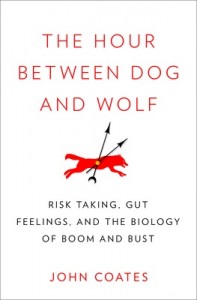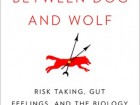 There are books written about the financial crisis, and there are books written about understanding financial crises in general. This book falls squarely in the latter category. To prevent the next financial crash, author-researcher John Coates believes that neurobiology holds the key. “Out of all the research devoted to explaining financial market instability, very little has involved looking at what happened physiologically to traders when caught up in a bubble or a crash. This is an extraordinary omission, comparable to studying … medicine without ever looking at a patient.” The study of behavioural finance is indeed growing, and among its leaders is John Coates, a senior research fellow in neuroscience and finance at the University of Cambridge.
There are books written about the financial crisis, and there are books written about understanding financial crises in general. This book falls squarely in the latter category. To prevent the next financial crash, author-researcher John Coates believes that neurobiology holds the key. “Out of all the research devoted to explaining financial market instability, very little has involved looking at what happened physiologically to traders when caught up in a bubble or a crash. This is an extraordinary omission, comparable to studying … medicine without ever looking at a patient.” The study of behavioural finance is indeed growing, and among its leaders is John Coates, a senior research fellow in neuroscience and finance at the University of Cambridge.
“Economists tend to view the assessment of financial risk as a purely intellectual affair—requiring the calculation of asset returns, probabilities, and the optimal allocation of capital—carried on for the most part rationally,” writes Coates in the introduction. “But to this bloodless account of decision-making I want to add some guts.” Indeed, over the next 260 or so pages, he does “add some guts.”
The first section lays the groundwork for physiology in the financial sphere. John Coates spent twelve years on Wall Street (at Goldman Sachs and Deutsche Bank), and his intimate knowledge of the working rhythms of this sector is reflected in the realistic portrayals of hypothetical traders, Logan, Scott, Martin, and Gwen. During down time, when the market is quiet, Coates writes, “traders use the lull to pay bills, plan their next ski trip, or talk to head-hunters.…” That certainly rings true.
When a rumour sweeps the trading floor that the Fed will make an unanticipated rate change, Coates describes the early-warning system that begins to fire in the most primitive, unconscious part of the brain, and how this unfolds into an all-out stress response. He intertwines descriptions of overt trading behaviour among the traders, who act as models of the hormonal-factual interplay, with a description of the physiology behind their behaviour. It is an engrossing account.
In the second section, Coates describes intuitive, or “gut,” thinking. There is a strong biological underpinning for extremely fast decision making. As Malcolm Gladwell memorably depicted in Blink, decisions are often made at the irrational sub-conscious level, because the rational to-and-fro deliberations of consequences simply take too long for the hypothetical traders.
In the third section, Coates writes, “Human biology obeys seasons of its own, and as traders make and lose money they are led almost irresistibly into recurrent cycles of euphoria, excessive risk-taking and crash. This dangerous pattern repeats itself in the financial markets every few years.” He delves into humanity’s strange and powerful attraction to new information. How the brain distinguishes between significant and trivial information, how patterns are recognized, and how this all translates into the traders’ world of rumour, bids, and asks, are masterfully woven together. Two hormones feature prominently in the blood, sweat, and tears of a thriving economy: dopamine, which “surges most powerfully when we perform a novel physical action that leads to unexpected reward,” and testosterone, which increases risk-taking (although not skill).
In the fourth and final section, Coates considers personal and market resilience. There are two approaches to mitigating chronic stress: mentally toughening the individual and changing the workplace. Toughness can be made from periods of short-lived stress and recovery. Building resilience in markets is more difficult. He provides evidence that a bull market is amplified by a testosterone feedback loop among traders and investors, and he suggests that bubbles are largely a phenomenon of T-levels. He poses the question whether markets could attain stability by including more women and older men. He reminds us that “most legendary investors, such as Warren Buffett and Benjamin Graham, achieved their status at a later stage in their lives, not as young men.” (p. 251)
This book is packed with succinct descriptions of research (collected in a superb 35-page Notes section) but the factual material always supports, and never overwhelms, the central narrative of financial decision makers carrying out their roles.
I do have a few quibbles. “Volker” should be “Volcker.” The index is incomplete; for example, mention of side effects of Alzheimer’s disease and Crohn’s disease appear on p.105 but do not appear in the index. Nor is the ‘irritable male syndrome,’ which is fleetingly touched on in conjunction with the October effect (p. 189), listed in the index.
This book should generate controversy among the Wall Street crowd. For one thing, Coates supports the use of physiological monitoring to determine the best participants on the trading floor each day. He points out such monitoring is already done in professional sports, the military, and even among certain members of the public who simply want to be in tune with their body. An emphasis on T-levels could lead to the exclusion of women and older men. (Other factors affecting T-levels are: the presence of rivals, how competitive the environment is, whether one is on a winning streak, and one’s birth order.) Another recommendation is to change the timetables of bonuses, vacations, and hiring.
The book is a readable mix of his research and others,’ and thankfully he has added diagrams and graphs to give a fuller picture. For example, Coates writes that he found morning testosterone levels predicted the trader’s afternoon profits. Sure enough, of the 17 traders sampled, the highest profit went to a high-testosterone (high-T) trader and the greatest loss to a low-T trader. However, some low-T traders racked up respectable profits and some high-T traders showed losses. The graph shows there is generous scatter to what is presented as a categorical statement.
Coates is the master of winding up a good anecdote with a droll punch line. For example, later in the same chapter, he describes correlating trading performance with a physical marker, the ratio of the lengths of the index and ring fingers, “2D:4D” (D=digit):
“When looking into the science behind the 2D:4D marker, we learned the following. Recall the surge in prenatal testosterone, occurring between the eighth and nineteenth week of gestation? This hormone has such powerful effects on masculinizing the foetus that it leaves traces all over his body, which later in life can be read off as a measure of prenatal androgen exposure, much like the high-water marks on a breakwater. 2D:4D is just one of these traces. There are others, […] like […] ano-genital distance, which is exactly what it sounds like. In many hospitals ano-genital distance is now routinely measured in newborns as a way of ascertaining if they have been exposed to an abnormal prenatal steroid environment, something that can be caused by environmental hormone disruptors, in other words[,] chemicals we put in the environment that act like oestrogens and can cause developmental problems in males, such as undescended testicles and, later in life, prostate cancer. But alas, ano-genital distance is not a marker that is readily collected from traders, although it was suggested that if we were to leave a photocopier in the middle of the office Christmas party we might end up with some samples.” (p. 174)
I had mixed feelings on first picking up the book. Very often, researchers in physiology succumb to the doctrine of biological determinism, a field of thought that was used to deny women the right to an education, not to mention jobs in the towers of finance. Chapter 9, “From Molecule to Market,” has a section on women in the financial world. Instead of “fight or flight”, he writes that women’s stress response is “tend-and-befriend” leading to increased affiliation. He writes (p.252) that women’s “greater numbers among risk-takers in the financial world could therefore help dampen the volatility.” During the excesses of the nineties, as the dot.com bubble was building, “most women I knew, both on Wall Street and off, were quite cynical about the excitement, and as a result were often dismissed as ‘not getting it’, or worse, resented as perennial killjoys.” (p.19) Coates suggests that a financial risk-taker requires three traits—a good call on the market, a hearty appetite for risk, and quick reactions—and of the three, computers now provide the quick executions, therefore the need for high T-levels has subsided. He writes, “the financial worlds need more long-term, strategic thinking, and the data indicate that women excel at this.” (p. 255) Reassuring words, indeed. ª

